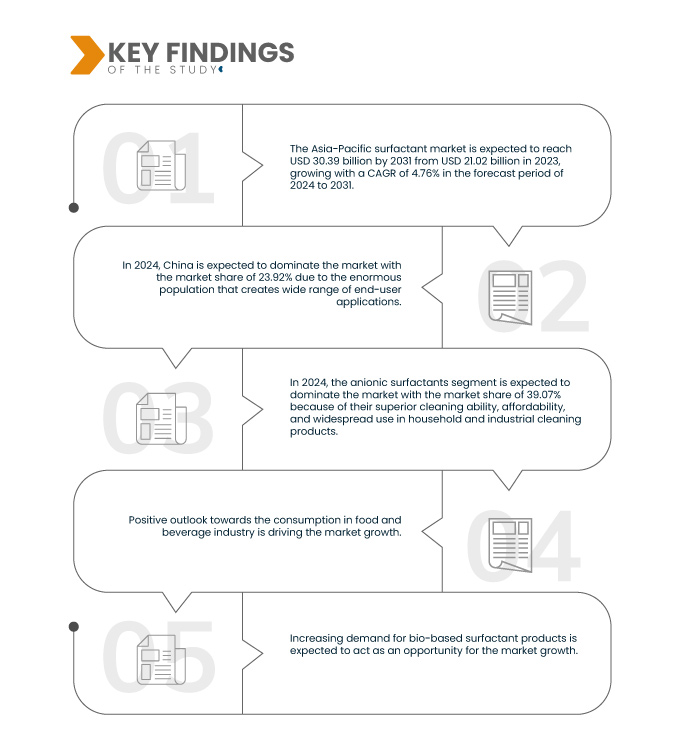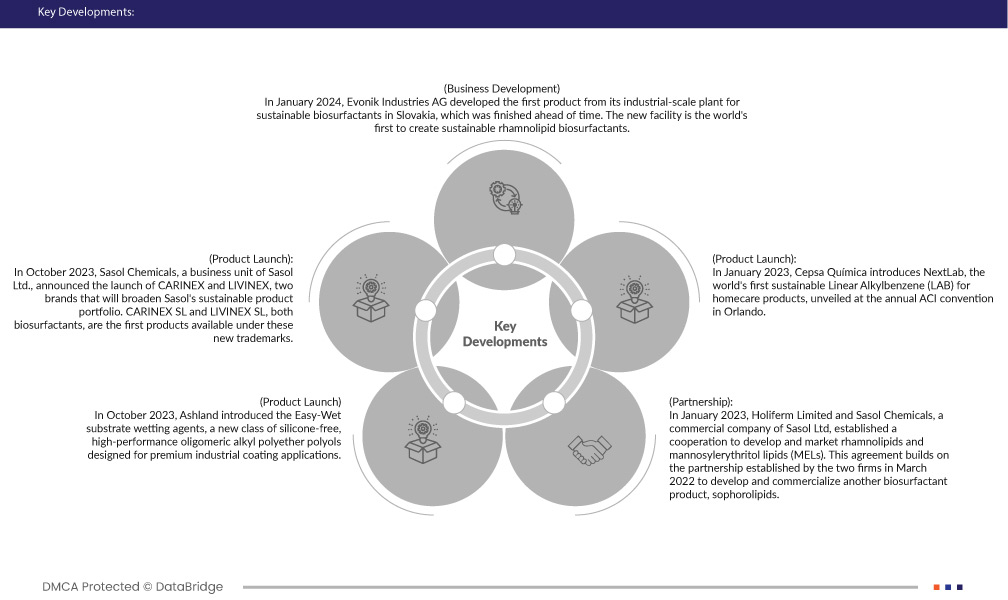Surfactants are molecules that exhibit both hydrophilic (water-attracting) and hydrophobic (water-repelling) properties. These compounds play a crucial role in reducing surface tension between liquids and solids or liquids and gases. In various industries, surfactants are employed to stabilize emulsions, enhance the wetting and spreading of liquids, and facilitate the removal of dirt or oil from surfaces. Their ability to alter interfacial properties makes surfactants integral in applications ranging from household cleaning products to pharmaceutical formulations and industrial processes. Overall, surfactants contribute to the efficiency and effectiveness of diverse liquid systems by modifying their surface and interfacial characteristics.
Access Full Report @ https://www.databridgemarketresearch.com/reports/asia-pacific-surfactant-market
Data Bridge Market Research analyzes that the Asia-Pacific Surfactant Market is expected to reach USD 30.39 billion by 2031, from USD 21.02 billion 2023, growing with a CAGR of 4.76% in the forecast period from 2024 to 2031.
Key Findings of the Study
Rising Demand for Surfactants in Personal Care and Hygienic Products
In the beauty and personal care industry, surfactants have varied applications such as foaming, cleansing, thickening, solubilizing, antimicrobial effects, penetration enhancement, and many other special effects. Their compatibility with oil and water is a key attribute of surfactant molecules that make them highly useful as cosmetic ingredients.
The increasing trend towards bio-surfactants for use in personal care products is expected to help in growth in the overall beauty and personal care surfactant market.
The increasing application of surfactants in-home care is expected to impact the market positively. The increasing consumer consciousness toward hygiene owing to the spread of various diseases and viruses has aided the expansion of the market with products in home care, which includes sanitizers, detergents, cleaning products, shampoo, hand wash, and others. The heavy demand for such products is expected to support the development of the market. Thus, the rising demand for surfactants is driving market growth.
Report Scope and Market Segmentation
|
Report Metric
|
Details
|
|
Forecast Period
|
2024 to 2031
|
|
Base Year
|
2023
|
|
Historic Years
|
2022 (Customizable to 2016-2021)
|
|
Quantitative Units
|
Revenue in USD Billion and Volume in Kilo Tons
|
|
Segments Covered
|
Type (Anionic Surfactants, Non-Ionic Surfactants, Cationic Surfactants, Amphoteric Surfactants, Silicone Surfactants, and Others), Substrate (Synthetic Surfactants and Bio-Based Surfactants), Application (Household Soaps and Detergents, Personal Care, Textile Processing, Industrial and Institutional Cleaning, Mining, Pharmaceuticals, Paints & Coatings, Oilfield Chemicals, Food Processing, Agricultural Chemicals, Pulp & Paper, Leather Manufacturing, Emulsion Polymerization, Foaming Agents, Lubricants and Fuel Additives, Plastics and Elastomers, Adhesives, Electroplating, and Others)
|
|
Countries Covered
|
China, India, Japan, South Korea, Malaysia, Thailand, Indonesia, Australia, New Zealand, Singapore, Philippines, Vietnam, Taiwan, and Rest of Asia-Pacific
|
|
Market Players Covered
|
Dow (U.S.), BASF SE (Germany), Sasol Ltd. (South Africa), Evonik Industries AG (Germany), KLK OLEO (Malaysia), Indorama Ventures Public Company Limited (Thailand), Kao Corporation (Japan), Reliance Industries Limited (India), Arkema (France), Godrej Industries Limited (India), Cargill, Incorporated (U.S.), CLARIANT (Switzerland), China Petrochemical Corporation (China), Stepan Company (U.S.), Lion Corporation (Japan), Aarti Industries Ltd. (India), ADEKA CORPORATION (Japan), Nouryon (Netherlands), The Lubrizol Corporation (U.S.), Lonza (Switzerland), SABIC (Saudi Arabia), Sumitomo Chemical Co., Ltd. (Japan), Cepsa (Spain), Bayer AG (Germany), SANYO CHEMICAL INDUSTRIES, LTD. (Japan), Croda International Plc (U.K.), Zanyu Technology Group (China), Ashland (U.S.), GALAXY (India), EOC Group (Belgium), Lankem (U.K.), DKS Co. Ltd. (Japan), TAIWAN NJC CORPORATION (Taiwan), 3M (U.S.), GEO (U.S.), FoglaGroup (India), Goulston (U.S.), Syensqo (Belgium), ABITEC (U.S.), and Matangi Industries (India), among others
|
|
Data Points Covered in the Report
|
In addition to the insights on market scenarios such as market value, growth rate, segmentation, geographical coverage, and major players, the market reports curated by the Data Bridge Market Research also include in-depth expert analysis, geographically represented company-wise production and capacity, network layouts of distributors and partners, detailed and updated price trend analysis and deficit analysis of supply chain and demand
|
Segment Analysis
The Asia-Pacific surfactant market is segmented into three notable segments based on type, substrate, and application.
- On the basis of type, the Asia-Pacific surfactant market is segmented into anionic surfactants, non-ionic surfactants, cationic surfactants, amphoteric surfactants, silicone surfactants, and others
In 2024, the anionic surfactants segment is expected to dominate the Asia-Pacific Surfactant Market
In 2024, the anionic surfactants segment is expected to dominate the market with a market share of 39.07% because of their superior cleaning ability, affordability, and widespread use in household and industrial cleaning products.
- On the basis of substrate, the Asia-Pacific surfactant market is segmented into synthetic surfactants and bio-based surfactants
In 2024, the synthetic surfactants segment is expected to dominate the Asia-Pacific Surfactant Market
In 2024, the synthetic surfactants segment is expected to dominate the market with a 50.23% market share as they are engineered to have specific properties, making them suitable for a wide range of applications in industries such as cleaning, personal care, and agriculture.
- On the basis of application, the Asia-Pacific surfactant market is segmented into household soaps and detergents, personal care, textile processing, industrial and institutional cleaning, mining, pharmaceuticals, paints & coatings, oilfield chemicals, food processing, agricultural chemicals, pulp & paper, leather manufacturing, emulsion polymerization, foaming agents, lubricants and fuel additives, plastics and elastomers, adhesives, electroplating, and others. In 2024, the household soaps and detergents segment is expected to dominate the market with a 39.30% market share
Major Players
Data Bridge Market Research analyzes DKS Co. Ltd. (Japan), Dow (U.S.), BASF SE (Germany), Lion Corporation (Japan), and Sasol Ltd. (South Africa), as the major players in the Asia-Pacific surfactant market.
Market Developments
- In January 2024, Evonik Industries AG developed the first product from its industrial-scale plant for sustainable biosurfactants in Slovakia, which was finished ahead of time. The new facility is the world's first to create sustainable rhamnolipid biosurfactants. Evonik Industires AG rhamnolipids are of extraordinarily high quality, and the company IP-protected, fermentation-based manufacturing process gives it a distinct market advantage
- In October 2023, Sasol Chemicals, a business unit of Sasol Ltd., announced the launch of CARINEX and LIVINEX, two brands that will broaden Sasol's sustainable product portfolio. CARINEX SL and LIVINEX SL, both biosurfactants, are the first products available under these new trademarks
- In October 2023, Ashland introduced the Easy-Wet substrate wetting agents, a new class of silicone-free, high-performance oligomeric alkyl polyether polyols designed for premium industrial coating applications. This enables the firm to produce game-changing innovations for the coating sector
- In January 2023, Holiferm Limited and Sasol Chemicals, a commercial company of Sasol Ltd, established a cooperation to develop and market rhamnolipids and mannosylerythritol lipids (MELs). This agreement builds on the partnership established by the two firms in March 2022 to develop and commercialize another biosurfactant product, sophorolipids. Sasol and Holiferm will create and commercialize formulations and uses for the novel compounds
- In January 2023, Cepsa Química introduces NextLab, the world's first sustainable Linear Alkylbenzene (LAB) for homecare products, unveiled at the annual ACI convention in Orlando. The NextLab portfolio, including NextLab-R, NextLab Low Carbon, and upcoming NextLab-C, offers eco-friendly alternatives with properties similar to traditional LAB. As the largest LAB producer globally, Cepsa aims to minimize the carbon footprint while maintaining high-performance detergents. NextLab-R and Low Carbon are already in industrial production, contributing to reduced carbon emissions and industry transformation
Regional Analysis
Geographically, the countries covered in the Asia-Pacific surfactant market are China, India, Japan, South Korea, Malaysia, Thailand, Indonesia, Australia, New Zealand, Singapore, Philippines, Vietnam, Taiwan, and rest of Asia-Pacific.
As per Data Bridge Market Research analysis:
China is estimated to be the dominant and fastest-growing county in the Asia-Pacific Surfactant Market
China is estimated to be the dominant and fastest-growing county in the market due to enormous population that creates wide range of end-user applications and its competitive advantage in production efficiency and cost-effectiveness.
For more detailed information about the Asia-Pacific Surfactant Market report, click here – https://www.databridgemarketresearch.com/reports/asia-pacific-surfactant-market












